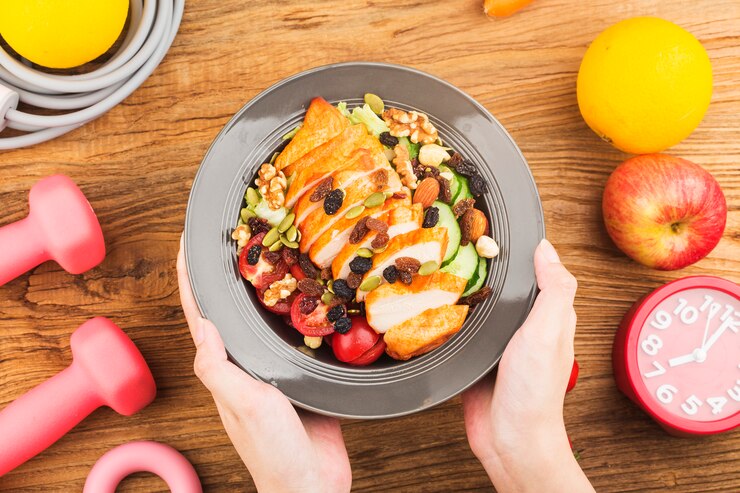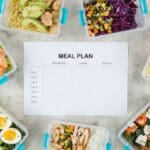If you’ve ever Googled “how to lose weight fast,” you probably already know the overwhelming number of diets, plans, and strategies out there. From keto to intermittent fasting to the latest “magic” cleanse, it’s hard to know what actually works—and what’s sustainable.
Here’s the truth: the best way to lose weight quickly and keep it off is by building a balanced meal plan. No gimmicks, no starvation, just smart food choices that fuel your body and keep you satisfied. A balanced meal plan doesn’t just help you shed pounds; it gives you energy, keeps your cravings in check, and helps you feel your best.
In this post, I’ll walk you through exactly how to build a meal plan that’s effective, easy to stick to, and tailored for fast weight loss. Ready? Let’s get started!
Why a Balanced Meal Plan Is Key to Weight Loss
Before we jump into the details, let’s talk about why a balanced meal plan is such a game-changer for weight loss. Diets that cut out entire food groups or force you to eat less than 1,200 calories a day might work for a week—but they’re not sustainable (or healthy). A balanced meal plan, on the other hand, gives your body exactly what it needs to lose fat without feeling deprived.
Here’s why it works:
- Keeps You Full: A mix of protein, healthy fats, and fiber helps control hunger and prevents overeating.
- Boosts Your Metabolism: Eating the right foods at the right times can keep your metabolism humming all day.
- Nutrient-Dense Choices: You’ll lose weight while fueling your body with the vitamins and minerals it needs to function at its best.
- No More Guesswork: When you have a plan, you’re less likely to grab that bag of chips or order takeout because “you didn’t know what to eat.”
Let’s dive into how to create this magical, balanced meal plan.
Step 1: Know Your Macronutrients (The Building Blocks of Your Meal Plan)
The foundation of a balanced meal plan is macronutrients—protein, carbohydrates, and fats. Each plays a key role in your weight loss journey, and getting the right balance is crucial.
1. Protein (The Satiety Hero):
Protein is your best friend when it comes to losing weight. It keeps you full, helps you maintain lean muscle, and even burns more calories during digestion.
- Examples: Chicken, turkey, fish, tofu, eggs, Greek yogurt, beans
- Daily Goal: Aim for about 30-40% of your calories from protein.
2. Healthy Carbs (The Energy Source):
Carbs are not your enemy! The trick is choosing the right ones—think whole grains, fruits, and vegetables instead of white bread or sugary snacks.
- Examples: Brown rice, quinoa, sweet potatoes, oats, berries, spinach
- Daily Goal: About 30-40% of your calories should come from healthy carbs.
3. Healthy Fats (The Unsung Hero):
Fats are essential for your body to function properly. Plus, they make meals satisfying and help regulate hormones involved in weight loss.
- Examples: Avocados, olive oil, nuts, seeds, fatty fish (like salmon)
- Daily Goal: About 20-30% of your calories from healthy fats.
Step 2: Plan Your Meals and Snacks
Now that you know the “what,” let’s move on to the “how.” Here’s how to structure your day for maximum weight loss:
Breakfast: Kickstart Your Day
Start your day with a meal that includes protein, healthy carbs, and some healthy fats. This combination stabilizes your blood sugar and sets the tone for the day.
- Example Meal:
- Scrambled eggs with spinach (protein + veggies)
- A slice of whole-grain toast (healthy carbs)
- A teaspoon of avocado spread (healthy fats)
Lunch: Keep It Balanced
Your lunch should be hearty enough to fuel you through the afternoon without weighing you down.
- Example Meal:
- Grilled chicken (protein)
- Quinoa salad with cucumbers and tomatoes (carbs + fiber)
- Drizzle of olive oil and lemon dressing (healthy fats)
Dinner: Light but Filling
Dinner should be light but satisfying, with a focus on lean protein and plenty of veggies.
- Example Meal:
- Baked salmon (protein + healthy fats)
- Steamed broccoli and roasted sweet potatoes (carbs + fiber)
Snacks: Stay Satisfied Between Meals
Healthy snacks keep you from getting too hungry between meals, which helps you avoid overeating later.
- Example Snacks:
- Greek yogurt with berries
- A handful of almonds
- Veggie sticks with hummus
Step 3: Portion Control for Weight Loss
Even healthy meals can lead to weight gain if your portions are too big. That’s why portion control is just as important as what you eat.
How to Control Portions Without Overthinking It:
- Use the “Plate Method”: Fill half your plate with veggies, a quarter with protein, and a quarter with healthy carbs.
- Pay Attention to Serving Sizes: For example, aim for 3-4 ounces of protein (about the size of your palm) per meal.
- Listen to Your Hunger Cues: Stop eating when you’re satisfied—not stuffed.
Step 4: Meal Prep for Success
Let’s be real: the hardest part about eating healthy is the time and effort it takes. That’s where meal prepping comes in. Spend a couple of hours on Sunday preparing your meals for the week, and you’ll save time, money, and stress.
Simple Meal Prep Tips:
- Cook proteins in bulk (like grilled chicken or baked fish) and store them in the fridge.
- Pre-chop veggies so they’re ready to grab and go.
- Portion out snacks into individual containers to avoid overeating.
Meal prepping doesn’t have to be complicated—it’s all about making healthy choices as convenient as possible.
Step 5: Stay Consistent and Make Adjustments
The key to success with any meal plan is consistency. But let’s be honest—life happens, and sometimes you’ll miss a meal or indulge in a treat. And that’s okay! What matters is that you stay on track most of the time and make adjustments as needed.
Tips for Staying Consistent:
- Keep healthy snacks on hand for busy days.
- Don’t beat yourself up over slip-ups—just get back on track.
- Adjust your plan as your needs change (for example, if your activity level increases, you may need more carbs).
Final Thoughts
Building a balanced meal plan for weight loss doesn’t have to be complicated or boring. By focusing on whole, nutrient-dense foods and getting the right balance of protein, carbs, and fats, you can lose weight without feeling deprived. Pair that with portion control and a little bit of meal prep, and you’ve got a recipe for success.
Remember, the goal isn’t just to lose weight fast—it’s to lose it in a way that’s sustainable and healthy. So, take it one meal at a time, stay consistent, and don’t forget to celebrate your progress along the way.
Have you tried building a meal plan for weight loss before? What’s worked for you? Let me know in the comments below—I’d love to hear your tips and experiences!




